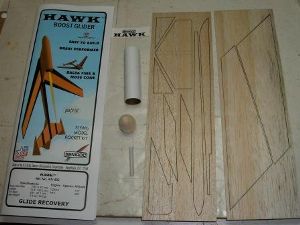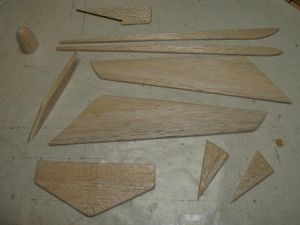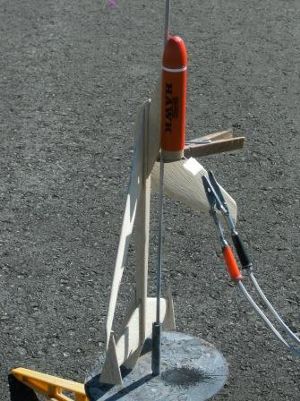| Construction Rating: | starstarstarstarstar |
| Flight Rating: | starstarstarstarstar_border |
| Overall Rating: | starstarstarstarstar_border |
| Diameter: | 0.74 inches |
| Length: | 12.40 inches |
| Manufacturer: | Semroc  |

Brief:
This is Semroc's Retro-Repro kit of the 1965 AMROCS Hawk. It is a swept-wing boost-glider that uses motor ejection to
change CG at apogee.
Construction:
The kit consists of a balsa nose cone, an 18mm motor tube, a launch lug, a waterslide decal, and two sheets of
laser-cut balsa parts.
The instructions in this Semroc kit were well written, logical, and generously illustrated. Construction is very straightforward. The laser-cut parts are well produced, and go together very smoothly. I found it easiest to sand to shape and pre-seal the parts before assembly. The parts fit together very precisely, and the model built very straight and true. I was impressed with the quality of balsa used in the kit. It was very hard, but still light and free of any irregular grain. Truly some of the best balsa I have seen in a rocket kit.


Finishing:
I sealed the balsa with a 50/50 solution of Titebond cement and water. I brushed this onto the shaped parts and let
it dry overnight. The next day I sanded the surfaces smooth with 220 grit sandpaper. I did no additional finishing to
the glider. My experience has been that this is the best finish for all-balsa gliders. Too much paint and smooth
surfaces tend to make them glide like a brick. I added a few extra coats of the diluted glue to the nose-cone and
painted the power-pod with Tamiya white primer and Red. Glide tests indicated that the nose-weight was needed and it
was my hope that the bright red would be easier to spot on the ground. The waterslide decal went on without a hitch.
Construction Rating: 5 out of 5

Flight:
Glide testing was surprisingly tricky. The model is very sensitive to slight changes in weight. As built, it stalled
badly, but just a small amount of clay in the nose was all it needed to balance. The main problem I found was that I
could not get the glider to turn at all. I tried steam-bending a wing or the tail, but it just refused to turn. I ended
up putting a small bit of clay on one wingtip to get it to turn. I would recommend you build it with the rudders turned
just 1/32nd of an inch to one side.
The recommeded motors are 1/2A6-2 and A8-3. I could not find a 1/2A motor so I flew it on an Estes A8-3 for the first flight. The Hawk jumped off the pad and flew in lazy circles until ejection. The kick from the motor caused it to loop and it flew with a slight stall on a long, gentle glide back. Recovery showed that a small chunk of the nose cone had popped off, perhaps from the force of ejection. This may have resulted in the stall.
I took a pinch of clay from the wingtip and placed it in the nose and flew it on a Quest A6-4. The height was good and it corkscrewed less, but the delay was too long and it was pointing down at ejection. The glide was very good and flat. Nice flight overall.
For the third flight I tried an Estes B6-4. Corkscrewed up but went nice and high. Ejection was hard to see, but seemed about right. It stalled again this time, and when recovered I found another chunk was missing from the nose. Perhaps some vent-holes are in order? The glider showed no other damage from the oversized motor, and I think it might be able to handle a C6-3, but I didn't try it.

Recovery:
The motor ejection is a very big kick. The Edmonds CiCi uses a similar motor ejection, but has vent-holes near the
nose. I think that might help. The swept-wings make this model very sensitive in balance and I think the chunks being
lost from the nose were causing the stall. I think a slight turn built into the tail or wings would be advised.
Overall, it was still a very impressive flier and stays up a long time on just an A. A very good performer.
Flight Rating: 4 out of 5
Summary:
This is a very good model at a very reasonable price. The materials are top-notch, and the laser-cutting makes it a
breeze to assemble. The people that saw this fly were very impressed and liked to way it looked. The model develops a
coating of ejection blast but otherwise held up pretty well. I thought it performed well for its type. If I built it
again, I would build a turn into it and provide a vent hole in the engine tube to ease that kick at apogee.
Overall Rating: 4 out of 5
Other Reviews
- Semroc Hawk By Tyler Jones (March 29, 2009)
Brief: The Hawk is a boost glider that uses a rocket engine to get itself in the air. It is a "Retro-Repro" of an older rocket. Semroc is selling them for $7.50 right now so I decided to pick one up. Construction: When I bought the kit I figured there wouldn't be very many pieces. I got it and found only 5 parts in the whole kit. It comes with: 1 BT-20J ...
- Semroc Hawk By Paul Morris (March 22, 2009)
Brief: A retro boost glider that was purchased for me by my nephew and niece for my birthday. This was the first model rocket that I have built since I had a stroke--and it proved a bit of a challenge. Construction: The kit comes in a bag and contains: motor mount 2 balsa sheets of parts balsa nose cone decal launch lug The balsa was light, ...
- Semroc Hawk By Matt Gillard (March 22, 2009)
Brief: A Retro-Repro production from 1965. The Hawk is a quick to build boost glider that ejects its motor and glides back down. Flies almost from the building board. Construction: Kit comes in a plastic bag and contains: 1 instruction booklet 2 3/32" balsa part sheets 1 BT-20 motor tube 1 Balsa nose cone 1 1/8" launch lug 1 Hawk decal ...
- Semroc Hawk By Robert Gustin (March 12, 2009)
Brief: The Semroc Hawk RetroRepro boost glider is a very simple to build and easy to fly rocket boosted glider. Based on the 1965 AMROCS Hawk, it ejects its motor to establish a stable, balanced glide. Construction: In the well packaged kit you get: 1 Instruction set 2 3/32" balsa part sheets 1 BT-20 motor tube 1 Balsa nose cone 1 1/8" launch lug ...
- Semroc Hawk By Hans "Chris" Michielssen (February 7, 2009)
Brief: I put my order into Semroc during their end of the year Christmas discount. My order was already over $40.00 and the Hawk was a free kit! I added an extra Hawk to my order. One to build, one to hoard. I had an AMROCS catalog in the early 1970s. I remember thinking it was a near twin to the Estes Falcon. With laser cut fins, this kit went together much easier than my ...
- Semroc Hawk By Howard Smart (January 31, 2009)
Brief: Near reproduction of a boost glider (BG) kit from 1965 made by AMROCS. This is a forward motor BG which changes from boost to glide by ejecting the motor casing, shifting its CG to the rear for gliding flight. Construction: This kit contains: (2) Balsa fin sheets - laser cut Nose cone - Balsa Motor mount 18mm Launch lug Decal Construction was ...
- Semroc Hawk By Chan Stevens (January 3, 2009)
Brief: The Hawk was originally introduced by Advanced Model Rocket Systems (AMROCS) in 1965. Its design is very much like the Estes Falcon. It's technically a boost glider, although it doesn't use a carrier vehicle, instead relying on ejecting the motor to handle the necessary shift in CG/CP relationship. This Semroc "retro repro" faithfully reproduces the original ...
 |
 |
Flights
Sponsored Ads
 |
 |











